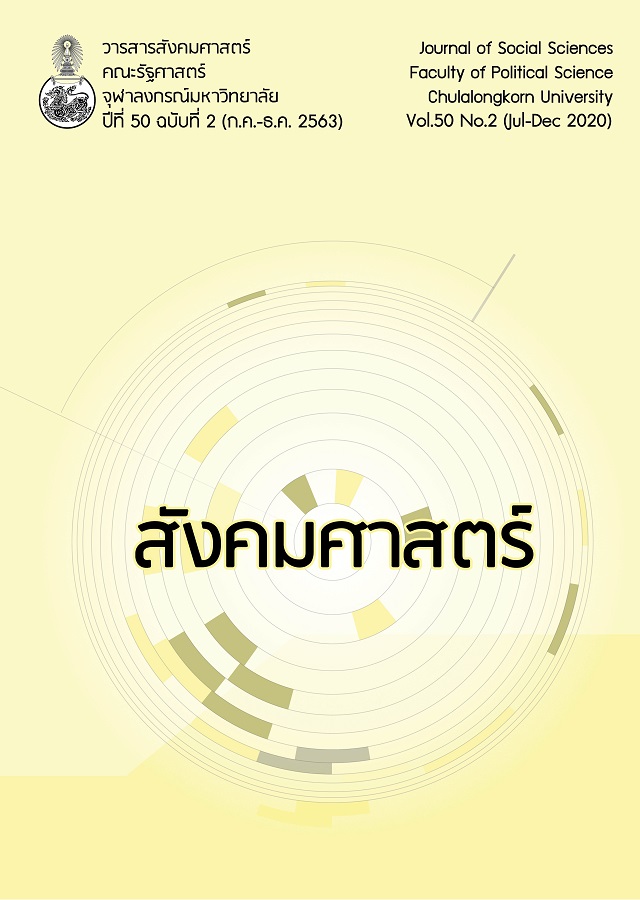ผลกระทบจากผลิตภาพปัจจัยการผลิตรวมต่อความเหลื่อมล้ำทางรายได้ของครัวเรือนโดยแบบจำลองดุลยภาพทั่วไปเชิงพลวัต กรณีศึกษาประเทศไทย
DOI:
https://doi.org/10.61462/cujss.v50i2.702คำสำคัญ:
ผลิตภาพปัจจัยการผลิตรวม, การเจริญเติบโตทางเศรษฐกิจ, ความเหลื่อมล้ำทางรายได้ของครัวเรือนบทคัดย่อ
งานศึกษานี้ศึกษาผลกระทบของผลิตภาพปัจจัยการผลิตที่มีต่อการเปลี่ยนแปลงของความเหลื่อมล้ำทางรายได้ของภาคครัวเรือนไทยภายใต้แบบจำลองดุลยภาพทั่วไปเชิงพลวัต พบว่าเมื่อกำหนดผลิตภาพการผลิตรวมสูงขึ้นร้อยละ 5 ในทุกภาคการผลิตส่งผลให้ผลิตภัณฑ์มวลรวมภายในประเทศที่แท้จริงเพิ่มขึ้นโดยในปีที่ 1 เพิ่มขึ้นร้อยละ 5 และ ร้อยละ 6.11 ในปีที่ 10 เมื่อเทียบกับกรณีฐาน และทำให้มูลค่าผลผลิตเพิ่มและรายได้ของภาคครัวเรือนมีแนวโน้มสูงขึ้นในทุกภาคการผลิต แต่ความเหลื่อมล้ำทางรายได้กลับมีแนวโน้มสูงขึ้นเมื่อเทียบกับกรณีฐาน โดยเฉพาะอย่างยิ่งในภาคเกษตรกรรม สาเหตุเพราะอัตราภาษีซึ่งเรียกเก็บจากรายได้ภาคครัวเรือนมีอัตราก้าวหน้าไม่มากพอที่จะลดรายได้กลุ่มครัวเรือนรายได้สูงที่สุดลง ดังนั้นข้อเสนอแนะเชิงนโยบายประกอบด้วย 2 ส่วนคือ 1) อัตราภาษีจะต้องมีอัตราก้าวหน้าที่เพิ่มสูงขึ้น และ 2) โยกย้ายกำลังแรงงาน และปัจจัยทุนของภาคครัวเรือนเกษตรไปสู่นอกภาคเกษตรกรรมที่มีแนวโน้มความเหลื่อมล้ำทางรายได้ที่น้อยกว่า
Downloads
เอกสารอ้างอิง
Andersson, P. Martin, and Andres F. Palacio Chaverra. 2016. “Structural Change and Income Inequality-Agricultural Development and Inter-sectoral Dualism in the Development World, 1960-2010.” Oasis 23(June): 99-122.
Archawa Paweenawat, Thitima Chucherd, and Nakarin Amarase. 2017. Uncovering Productivity Puzzles in Thailand: Lessons from Microdata. Bangkok: Puey Ungphakorn Institute for Economic Research.
Atkinson, Anthony B. 2015. Inequality: What Can We Done? Boston: Harvard University Press.
Bastagli, Francesca, David Coady, and Sanjeev Gupta. 2012. “Income Inequality and Fiscal Policy.” Washington, DC: International Monetary Fund.
Baymul, Cinar, and Kunal Sen. 2019. “Kuznets Revisited: What Do We Know about the Relationship between Structural Transformation and Inequality?” Asian Development Review 36(1): 136–167.
Cornia, Andrea Giovanni. 2003. “The Impact of Liberalisation and Globalisation on Income Inequality in Developing and Transitional Economies.” CESifo Working Paper Series No. 843. Munich: CESifo Economic Studies.
Decaluwé, Bernard, Andre Lemelin, Veronique Robichaud, and Helene Maisonnave. 2013. PEP-1-t. Standard PEP Model, Single Country, Recursive Dynamic Version. Kasarani, Nairobi: Partnership for Economic Policy (PEP) Research Network.
Dilaka Lathapipat. 2013. “The Influence of Family Wealth on the Educational Attainments of Youths in Thailand.” Economics of Education Review 37(December): 240–257.
Dollar, David, and Aart Kraay. 2001. Growth Is Good for the Poor. Washington DC: The World Bank.
Joumard, Isabelle, Mauro Pisu, and Debbie Bloch. 2012. “Tackling Income Inequality: The Role of Taxes and Transfers.” OECD Journal: Economic Studies 2012(1): 37-70. Accessed May 10, 2019. http://dx.doi.org/10.1787/eco_studies-2012-5k95xd6l65lt.
Kanokwan Chancaroenchai. 2008. Karnsuksa Palitaparp Karnpalit Khong Rabob Sethakij Thai Parn Viteekarn GARCH-M. [Productivity Growth and TFP Measurement in Thai Economy Using a GARCH-M Approach]. Bangkok: Thailand Research Fund. (in Thai)
Kim, Sung Tai, Young Jun Chun, and Seung-Rae Kim. 2013. “The Effect of R&D Investment on Economic Inequality in Korea.” Korea and the World Economy 14(1):173-206.
Kuznets, Simon. 1955. “Economic Growth and Income Inequality.” The American Economic Review 45(1): 1-28.
Lin, Justin Yifu, and Volker Treichel. 2012. Learning from China’s Rise to Escape the Middle-Income Trap: A New Structural Economics Approach to Latin America. Washington, DC: The World Bank.
Organisation for Economic Co-operation and Development. 2012. Economic Policy Reforms 2012: Going for Growth. Paris: OECD Publishing. Accessed December 19, 2019. https://read.oecd-ilibrary.org/economics/economic-policy-reforms-2012_growth-2012-en#page3.
-----. 2001. Measuring Productivity: Measurement of Aggregate and Industry-level Productivity Growth: OECD Manual. Paris: Organisation for Economic Co-Operational Development.
Organisation for Economic Co-operation and Development/International Labour Organization. 2017. How Immigrants Contribute to Thailand’s Economy. Paris: OECD Publishing.
Ojha, Vijay P., Basanta K. Pradhan, and Joydeep Ghosh. 2013. “Growth, Inequality and Innovation: A CGE Analysis of India.” Journal of Policy Modeling 35(6): 909-927.
Oyvat, Cem. 2016. “Agrarian Structures, Urbanization, and Inequality.” World Development 83(July): 207-230.
Paitoon Kraipornsak. 1998. “Botbart Khong Karn Khayaitua Dan Palitaparp Pudjai Karn Palit Doi Ruam Nai Sethakij Thai.” [The Role of Total Factor Productivity Growth in the Thai Economy]. Thammasat Economic Journal 16(2): 5-54. (in Thai)
Pranee Tinakorn, and Chalongphob Sussangkarn. 1998. Total Factor Productivity Growth in Thailand: 1980-1995. Bangkok: Thailand Development Research Institute.
Ravallion, Martin. 1997. Can High-Inequality Developing Countries Escape Absolute Poverty? Washington, DC: The World Bank.
Solow, Robert. 1956. “A Contribution to the Theory of Economic Growth.” The Quarterly Journal of Economics 70(1): 65–94.
Thanapol Srithanpong. 2016. Firm Productivity in Thai Manufacturing Industries: Evidence from Firm-level Panel Data. Bangkok: Puey Ungphakorn Institute for Economic Research.
Thorbecke, Erik. 1992. Adjustment and Equity in Indonesia. Paris: Development Centre, Organisation for Economic Co-operation and Development (OECD).
Wilkinson, Richard, and Kate Pickett. 2009. The Spirit Level: Why Greater Equality Makes Societies Stronger. London: Bloomsbury Press.
ดาวน์โหลด
เผยแพร่แล้ว
รูปแบบการอ้างอิง
ฉบับ
ประเภทบทความ
สัญญาอนุญาต
ลิขสิทธิ์ (c) 2020 คณะรัฐศาสตร์ จุฬาลงกรณ์มหาวิทยาลัย

อนุญาตภายใต้เงื่อนไข Creative Commons Attribution-NonCommercial-NoDerivatives 4.0 International License.
เงื่อนไขการอนุญาตสาธารณะ
นโยบายลิขสิทธิ์และการอนุญาต
วารสารสังคมศาสตร์ จุฬาลงกรณ์มหาวิทยาลัย เผยแพร่เนื้อหาทั้งหมดภายใต้ สัญญาอนุญาตครีเอทีฟคอมมอนส์แบบแสดงที่มา-ไม่ใช้เพื่อการค้า-ไม่ดัดแปลง 4.0 นานาชาติ (CC BY-NC-ND 4.0)
ลิขสิทธิ์
บทความทั้งหมดที่ตีพิมพ์ในวารสารสังคมศาสตร์ จุฬาลงกรณ์มหาวิทยาลัย เป็นลิขสิทธิ์ของ คณะรัฐศาสตร์ จุฬาลงกรณ์มหาวิทยาลัย ผู้เขียนจะโอนสิทธิ์ทั้งหมดให้แก่วารสารเมื่อบทความได้รับการตอบรับให้ตีพิมพ์
สัญญาอนุญาต CC BY-NC-ND 4.0
ภายใต้สัญญาอนุญาตนี้:
-
แสดงที่มา (BY): ผู้ใช้ต้องแสดงที่มาโดยอ้างอิงถึงผู้เขียน คณะรัฐศาสตร์ จุฬาลงกรณ์มหาวิทยาลัย และวารสารสังคมศาสตร์ จุฬาลงกรณ์มหาวิทยาลัย พร้อมทั้งให้ลิงก์ไปยังสัญญาอนุญาต และระบุหากมีการเปลี่ยนแปลง ทั้งนี้สามารถทำได้ในลักษณะที่สมเหตุสมผล แต่ต้องไม่ทำในลักษณะที่แสดงว่าผู้อนุญาตให้การรับรองผู้ใช้หรือการใช้งานดังกล่าว
-
ไม่ใช้เพื่อการค้า (NC): ผู้ใช้ไม่สามารถใช้เนื้อหาเพื่อวัตถุประสงค์ทางการค้า การใช้งานเชิงพาณิชย์จะต้องได้รับอนุญาตเป็นลายลักษณ์อักษรล่วงหน้าจากผู้เขียนและคณะรัฐศาสตร์ จุฬาลงกรณ์มหาวิทยาลัย
-
ไม่ดัดแปลง (ND): หากผู้ใช้นำเนื้อหาไปรวม ดัดแปลง หรือต่อยอด ผู้ใช้ไม่สามารถเผยแพร่งานที่ดัดแปลงนั้นได้ การดัดแปลงผลงานจะต้องได้รับอนุญาตเป็นลายลักษณ์อักษรล่วงหน้าจากผู้เขียนและคณะรัฐศาสตร์ จุฬาลงกรณ์มหาวิทยาลัย
นโยบายการเข้าถึงแบบเปิด
วารสารสังคมศาสตร์ จุฬาลงกรณ์มหาวิทยาลัย ให้การเข้าถึงเนื้อหาแบบเปิดโดยทันทีตามหลักการที่ว่าการทำให้งานวิจัยสามารถเข้าถึงได้อย่างเสรีแก่สาธารณะจะสนับสนุนการแลกเปลี่ยนความรู้ในระดับโลก ผู้ใช้สามารถอ่าน ดาวน์โหลด คัดลอก เผยแพร่ พิมพ์ ค้นหา หรือเชื่อมโยงไปยังเนื้อหาฉบับเต็มของบทความได้โดยไม่ต้องขออนุญาตล่วงหน้าจากผู้จัดพิมพ์หรือผู้เขียน ทั้งนี้เป็นไปตามสัญญาอนุญาต CC BY-NC-ND 4.0
นโยบายการเก็บบันทึกด้วยตนเอง
ผู้เขียนสามารถเก็บบันทึกบทความฉบับตีพิมพ์สุดท้าย ต้นฉบับที่ส่ง (preprint) หรือฉบับที่ผ่านการประเมิน (postprint) ในคลังสถาบันหรือเว็บไซต์ส่วนตัวได้ โดยต้องมีการอ้างอิงการตีพิมพ์ครั้งแรกในวารสารสังคมศาสตร์ จุฬาลงกรณ์มหาวิทยาลัย พร้อมระบุแหล่งอ้างอิงที่สมบูรณ์และลิงก์ไปยังเว็บไซต์ของวารสาร
การขออนุญาต
สำหรับการใช้งานนอกเหนือจากที่ครอบคลุมโดยสัญญาอนุญาต CC BY-NC-ND 4.0 กรุณาติดต่อ:
กองบรรณาธิการ
วารสารสังคมศาสตร์ จุฬาลงกรณ์มหาวิทยาลัย
คณะรัฐศาสตร์ จุฬาลงกรณ์มหาวิทยาลัย
Email: cusocscij@gmail.com
สำหรับข้อมูลเพิ่มเติมเกี่ยวกับสัญญาอนุญาตครีเอทีฟคอมมอนส์แบบแสดงที่มา-ไม่ใช้เพื่อการค้า-ไม่ดัดแปลง 4.0 นานาชาติ กรุณาเยี่ยมชม: https://creativecommons.org/licenses/by-nc-nd/4.0/deed.th





